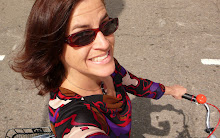Anne normally works hard and often into the night. So when Friday rolled around, she decided to take advantage of France’s fast-disappearing phenomenon of the 35-hour work week and took a day off to galavant around Paris with me. I wanted to go to the Samuel Beckett expo at the Beaubourg, and so at the last minute she decided to leave her briefcase at home and hop on the metro with me. She experienced feelings of guilt for about an hour, but I reassured her that she deserved the day off and that she was doing the right thing. By the time we arrived at Les Halles and went shopping for des belles fringues at Kookaï, she had forgotten all about her feelings of guilt. I tried to explain to her that she was having the French equivalent of Ferris Bueller’s Day Off, but she had never heard of the film.
The Beckett exhibit was, well, Beckettian as they say. The room was arranged in black in white, using negative space in a way that emphasized the void that is often thematic in Beckett’s oeuvre. Anne was a political science major, and so once again (having been a French Lit major), I had to explain the exhibit to a friend. How does one explain Beckett? The exhibit began with a projection of a performance of Pas Moi, a mere mouth on a black background speaking in rapid fire like an auctioneer. You could listen to stations with clips from Waiting for Godot in one of three languages, as well as Happy Days and Endgame. At the end of the exhibit was a room decorated in black and white, as minimalist as a Beckettian set, with chairs in which you could listen to narrations of any number of Beckett’s plays. There was one photo by I.C. Rapoport of Beckett in New York that I liked in particular, a black and white image of the author walking through a non-descript urban wasteland, just like Vladimir and Estragon, the title of the photograph simply, “Samuel Beckett à New York, 1965.”

I visited the permanent collection of the Beaubourg as well, and remarked how the designer incorporates views of Paris as part of the art on display. In certain rooms, the walls open up to and frame Paris’ monuments like the Tour Eiffel or Sacre Coeur like a photograph. To top it off, the Beaubourg probably has the best museum café (albeit expensive and snobby) that I’ve ever witnessed (even better than the NY MoMA). On the top floor, you get a practically panoramic view of Paris, and each table comes with a single red rose. I think a scene in Sex and the City was filmed here, when Carrie met Alexandr Petrovsky’s ex-wife. I couldn’t have asked for a better way spend the afternoon with my pal in Paris.


No comments:
Post a Comment